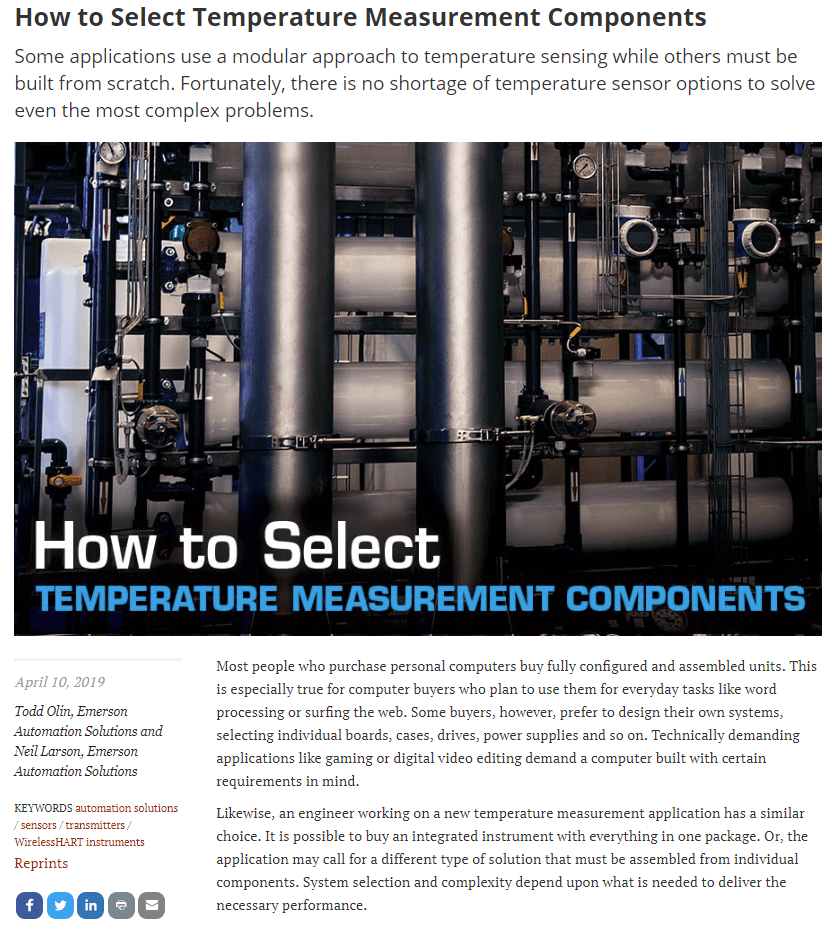When it comes to measuring temperature, there are a multitude of ways to do this. Do-it-yourselfers might use simple RTD or thermocouple sensors right into a microcontroller and display to provide basic temperature readings for their grills and BBQ pits. Or they could buy a ready-made transmitter and software to send the readings to their smart phones.
For industrial process manufacturers and producers, there are still many choices. In a Process Heating magazine article, How to Select Temperature Measurement Components, Emerson’s Todd Olin and Neil Larson describe the continuum of options and things to consider when selecting the right temperature measurement solution for your application.
 Todd and Neil open by comparing selection choices to how one might buy a personal computer.
Todd and Neil open by comparing selection choices to how one might buy a personal computer.
Most people who purchase personal computers buy fully configured and assembled units. This is especially true for computer buyers who plan to use them for everyday tasks like word processing or surfing the web. Some buyers, however, prefer to design their own systems, selecting individual boards, cases, drives, power supplies and so on.
Similarly, the choice for temperature measurement can be for the sensor and how to connect it into the control system, or a fully integrated temperature transmitter that can pass an analog or digital signal back to the control system.
They highlight the sensor types.
An electronic temperature sensor creates an analog signal in response to the temperature it detects. Resistance temperature detectors (RTD) and thermistors change their resistance in proportion to changes in temperature. Thermocouples (TC) produces an electrical voltage that changes in proportion to the difference in temperature detected at two different points. A thermocouple determines a temperature difference, so it is necessary to have a known reference.
These sensors provide raw analog signals that must get converted somewhere into useful information. A basic approach for this signal processing:
…is a single panel meter temperature display. These are typically off-the-shelf units designed to receive a signal from a single sensor. Most have the ability to work with a variety of RTD and thermocouple types, depending on the specific terminal arrangement or software configuration step.
Often these provide local temperature display and provide a standard 4-20mA signal back to the control system. The sensor wires must be connected back to these displays which may induce noise if they are not close to the sensors.
Incorporating a transmitter with the sensor provides greater capabilities, including:
…basic functions such as providing a reference for thermocouples, converting to appropriate engineering units, damping and ranging. Smart transmitters can add diagnostic functions to monitor the sensor itself, look for problems that might be developing and support redundant sensor arrangements.
Read the article for more on the capabilities of these transmitters and installation options, including wireless, depending on the needs of the application.
Visit the Temperature Measurement section on Emerson.com for more on the types and considerations for selecting the best solutions for your application. You can also connect and interact temperature measurement experts in the Measurement Instrumentation group in the Emerson Exchange 365 community and at the Sept. 23-27 Emerson Exchange conference in Nashville.






